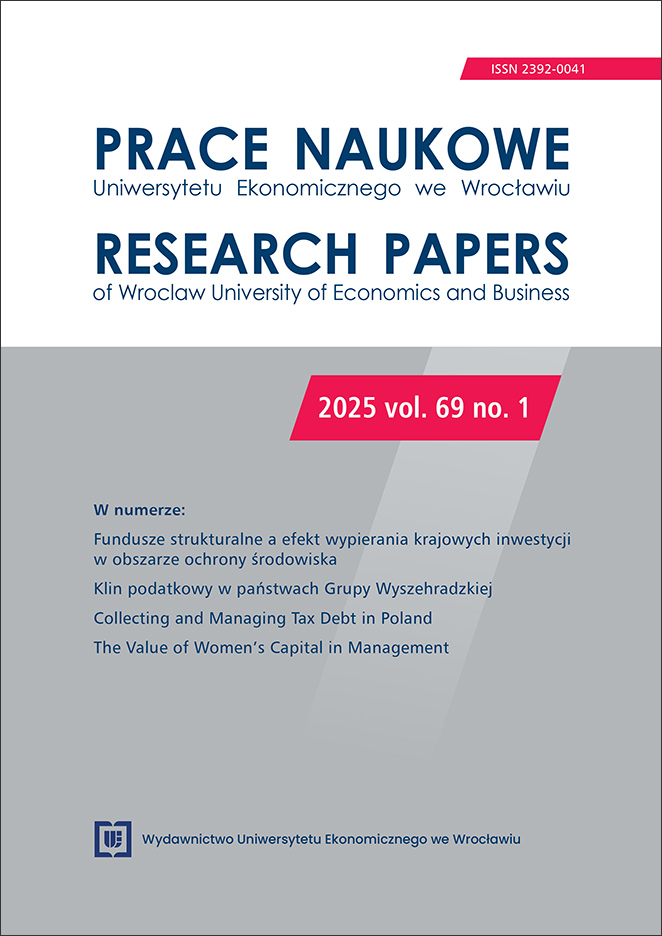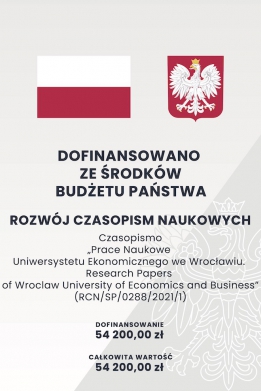Value-at-Risk Forecasting for Investment Portfolios
DOI:
https://doi.org/10.15611/pn.2025.1.10Keywords:
Value-at-Risk, GARCH model, investment portfolios, market riskAbstract
Aim: The aim of this paper is to identify the Value-at-Risk estimation method that generates the most accurate forecasts for investment portfolios. The paper assumes that the accuracy of Value-at-Risk forecasts is measured using the Kupiec and Christoffersen tests. Additionally, the impact of the portfolio construction on its vulnerability to risk was also analyzed.
Methodology: The study was conducted using data on stock market indices obtained from Stooq.com. The historical simulation method and two GARCH(1,1) models with different theoretical distributions were used to estimate Value-at-Risk. Furthermore, the results were validated and verified, taking into account events such as Brexit, the COVID-19 pandemic, and Russia's attack on Ukraine.
Results: The most accurate Value-at-Risk forecasts were obtained using the GARCH(1,1) model with
a skewed t-student distribution. Additionally, in almost every case, the GARCH models generated more accurate forecasts than the historical simulation.
Implications and recommendations: Assets and investment portfolios are often exposed to losses caused by an increase in market risk during periods of significant market changes. VaR forecasting is one of the key tools used in financial risk analysis, particularly in the context of investment portfolios. Investors should combine VaR with other analytical tools and regularly test and update models depending on changing market conditions.
Originality/value: This issue is crucial from the perspective of risk management by banks and other financial institutions. Currently, there is no recommended Value-at-Risk estimation method that serves as an industry standard. Therefore, an attempt was made to develop and test an approach within the ways of determining the value at risk.Downloads
References
Abounoori, E., Elmi, Z. i Nademi, Y. (2016). Forecasting Tehran Stock Exchange Volatility; Markov Switching GARCH Approach. Physica A, 445, 264-282.
Alexander, C., Lazar, E. i Stanescu, S. (2013). Forecasting VaR Using Analytic Higher Moments for GARCH Processes. International Review of Financial Analysis, 30, 36-45.
Alexander, C. i Lazar, E. (2006). Normal Mixture GARCH(1,1): Applications to Exchange Rate Modelling. Journal of Applied Econometrics, 21(3), 307-336.
Angelidis, T., Benos, A. i Degiannakis, S. (2004). The Use of GARCH Models in VaR Estimation. Statistical Methodology, 1(1-2), 105-128.
Berkowitz, J. i O’Brien, J. (2002). How Accurate Are Value-at-Risk Models at Commercial Banks? The Journal of Finance, 57(3), 1093-1111.
Brooks, C. i Persand, G. (2003). Volatility Forecasting for Risk Management. Journal of Forecasting, 22(1), 1-22.
Chen, C. W. S. i Watanabe, T. (2018). Bayesian Modeling and Forecasting of Value-at-Risk via Threshold Realized Volatility, Applied Stochastic Models in Business and Industry, 35, 747-765.
Duda, M. i Schmidt, H. (2009). Evaluation of Various Approaches to Value at Risk. Lund University.
Elenjical, T., Mwangi, P., Panulo, B. i Huang, C. (2016). A Comparative Cross-Regime Analysis on the Performance of GARCH-based Value-at-Risk Models: Evidence from the Johannesburg Stock Exchange. Risk Management, 18(2/3), 89-110.
Fan, J. i Gu, J. (2003). Semiparametric Estimation of Value at Risk. Econometrics Journal, 6(2), 261-290.
Fiszeder, P., Fałdziński, M. i Molnár, P. (2023). Modeling and Forecasting Dynamic Conditional Correlations with Opening, High, Low, and Closing Prices. Journal of Empirical Finance, 70, 308-321.
Guermat, C. i Harris, R. D. F. (2002). Forecasting Value at Risk Allowing for Time Variation in the Variance and Kurtosis of Portfolio Returns. International Journal of Forecasting, 18(3), 409-419.
Jorion, P. (2007). Value-at-Risk – The New Benchmark for Managing Financial Risk (3. wyd., s. 274-285). McGraw–Hil.
Kakade, K., Jain, I. i Mishra, A. K. (2022). Value-at-Risk Forecasting: A Hybrid Ensemble Learning GARCH-LSTM Based Approach. Resources Policy, 78, 102903.
Karandikar, R. G., Deshpande, N. D., Khaparde, S. A. i Kulkarni, S. V. (2009). Modelling Volatility Clustering in Electricity Price Return Series for Forecasting Value at Risk. European Transactions on Electrical Power, 19, 15-38.
Komisja Nadzoru Finansowego (2024). Metodyka badania i oceny nadzorczej BION powszechnych towarzystw emerytalnych. https://www.knf.gov.pl/knf/pl/komponenty/img/METODYKA_BION_PTE_wydanie%203_2024_89141.pdf
Lazar, E. i Xue, X. (2020). Forecasting Risk Measures Using Intraday Data in a Generalized Autoregressive Score Framework. International Journal of Forecasting, 36(3), 1057-1072.
McAleer, M. i Da Veiga, B. (2008). Single-Index and Portfolio Models for Forecasting Value-at-Risk Thresholds. Journal of Forecasting, 27(3), 217-235.
McMillan, D. G. i Speight, A. E. H. (2007). Value-at-Risk in Emerging Equity Markets: Comparative Evidence for Symmetric, Asymmetric, and Long-Memory GARCH Models. International Review of Finance, 7(1-2), 1-19.
Sadeghi, M. i Shavvalpour, S. (2006). Energy Risk Management and Value at Risk Modeling. Energy Policy, 34(18), 3367-3373.
Santos, A. A. P., Nogales, F. J. i Ruiz, E. (2013). Comparing Univariate and Multivariate Models to Forecast Portfolio Value-at-Risk. Journal of Financial Econometrics, 11(2), 400-441.
Sharma, M. (2012). Evaluation of Basel III Revision of Quantitative Standards for Implementation of Internal Models for Market Risk. IIMB Management Review, 24(4), 234-244.
Wong, C. i So, M. K. P. (2003). On Conditional Moments of GARCH Models, with Applications to Multiple Period Value at Risk Estimation. Statistica Sinica, 13, 1015-1044.
Wong, Z. Y., Chin, V. C. i Tan, S. H. (2016). Daily Value-at-Risk Modeling and Forecast Evaluation: The Realized Volatility Approach. The Journal of Finance and Data Science, 2(3), 171-187.
Downloads
Published
License
Copyright (c) 2025 Jakub Tomczak, Natalia Nehrebecka

This work is licensed under a Creative Commons Attribution-ShareAlike 4.0 International License.
Accepted 2025-04-14
Published 2025-05-28









